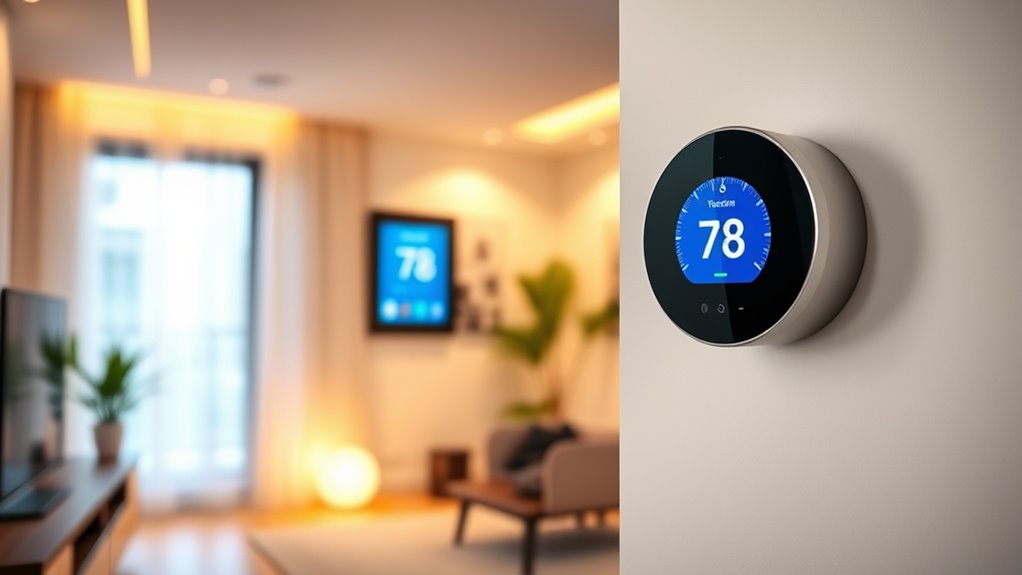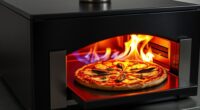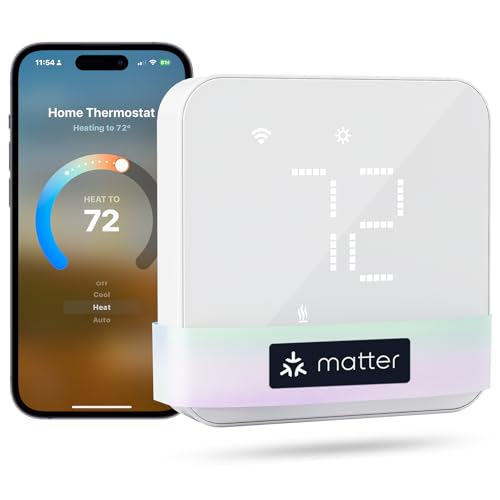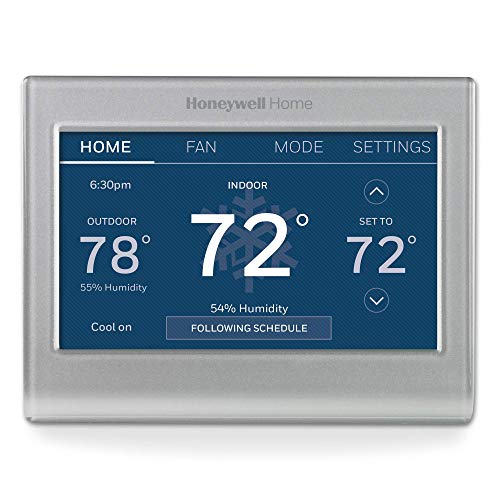If you’re looking to upgrade your home with the latest smart thermostats, I recommend checking out options like ecobee’s premium models, Nest and Sensi for energy savings, and budget-friendly choices like Amazon’s Smart Thermostat. These devices offer sleek design, easy DIY installation, and compatibility with major smart home platforms. They let you control your home’s comfort remotely and optimize energy use effortlessly. Stay tuned to discover which models fit your needs best.
Key Takeaways
- Consider models with sleek, customizable displays and intuitive touchscreens for enhanced user experience.
- Prioritize thermostats compatible with your HVAC system, including support for smart home ecosystems like Alexa, Google, and Apple.
- Look for energy-saving features such as smart scheduling, occupancy detection, and energy reports to maximize efficiency in 2025.
- Choose options with easy DIY installation, Wi-Fi connectivity, and remote management for convenient home climate control.
- Evaluate advanced features like air quality monitoring, security integration, and Matter support for a comprehensive smart home upgrade.
Sensi Smart Thermostat with Wi-Fi and Alexa Compatibility
If you’re looking for an easy-to-install smart thermostat that offers both energy savings and seamless voice integration, the Sensi Smart Thermostat with Wi-Fi and Alexa compatibility is an excellent choice. I found it simple to set up, thanks to clear app instructions and its compatibility with most HVAC systems—no common wire needed in many cases. It helps cut energy costs by around 23% and offers remote control via the mobile app. Plus, its sleek design, user-friendly interface, and smart features like maintenance alerts and voice commands make managing my home’s climate effortless. It’s a reliable, privacy-conscious option that blends convenience with efficiency.
Best For: homeowners seeking an easy-to-install, energy-efficient smart thermostat with seamless voice control and compatibility with most HVAC systems.
Pros:
- Simple DIY installation with clear app instructions and no common wire needed in many cases
- Helps reduce energy costs by approximately 23% and offers remote control via mobile app
- User-friendly design with smart features like maintenance alerts, voice compatibility, and privacy assurance
Cons:
- Some users experience a delay of 20-25 seconds between temperature adjustment and system response
- Limited voice assistant support (no Bixby compatibility)
- May not be suitable for very complex multi-zone HVAC systems without additional configuration
ecobee Smart Thermostat Enhanced
The ecobee Smart Thermostat Enhanced stands out for its advanced occupancy-based energy savings, making it an ideal choice for homeowners who want to optimize comfort while reducing costs. It adjusts temperatures based on occupancy, sleep, and away modes, saving up to 26% annually on heating and cooling. It preheats or precools your home before you arrive and maintains comfort day and night while regulating humidity for a consistent feel. Compatible with most 24 VAC HVAC systems, it’s easy to install with the included Power Extender Kit if you lack a C-wire. Controlled via app or voice, it offers seamless smart home integration and flexible, efficient climate management.
Best For: homeowners seeking an energy-efficient, smart thermostat that seamlessly integrates with their home automation system and offers advanced occupancy-based climate control.
Pros:
- Automates energy savings by adjusting temperatures based on occupancy, sleep, and away modes, saving up to 26% annually.
- Compatible with most 24 VAC HVAC systems and includes a Power Extender Kit for easy installation without a C-wire.
- Supports remote control and voice commands via app, Apple Watch, Siri, Alexa, and Google Assistant, ensuring convenient operation.
Cons:
- Requires professional installation if no C-wire is present, which may increase setup complexity and cost.
- Some users experience issues with display behavior, such as turning off when approached, or website login stability.
- Slightly larger dimensions and weight may not suit very compact or discreet installation preferences.
ecobee Smart Thermostat Essential – Wi-Fi Programmable Thermostat
The ecobee Smart Thermostat Essential stands out as an ideal choice for homeowners seeking energy savings and easy scheduling without complex installation. It can save up to 23% annually on heating and cooling costs by automatically adjusting temperatures when you’re away or home. The setup is straightforward, compatible with 85% of HVAC systems, and doesn’t require a C-wire—just use the ecobee Power Extender Kit. The color touchscreen makes adjustments simple, and free software upgrades keep it current. Plus, it integrates effortlessly with Apple HomeKit, Google Assistant, and Alexa, giving you voice control and smart home automation at your fingertips.
Best For: homeowners seeking an easy-to-install, energy-efficient smart thermostat compatible with most HVAC systems and smart home ecosystems.
Pros:
- Easy DIY installation with no C-wire required using the Power Extender Kit
- Energy savings of up to 23% annually through automated scheduling and remote monitoring
- Seamless integration with Apple HomeKit, Google Assistant, and Amazon Alexa for voice control and automation
Cons:
- Compatibility limited to 85% of HVAC systems; some systems may require additional setup or may not be compatible
- Lacks advanced features found in higher-end models, such as detailed energy reports or advanced zoning
- No physical buttons—reliance on touchscreen may be less convenient in certain lighting conditions
Amazon Smart Thermostat
For homeowners seeking an affordable, easy-to-install smart thermostat that seamlessly integrates with Alexa, the Amazon Smart Thermostat stands out. Released in 2021, it’s compatible with most 24V HVAC systems, including heat pumps and radiant boilers, but not with high-voltage setups. It’s ENERGY STAR certified, saving about $50 annually on energy bills, and features a sleek, minimalist design. Setup is straightforward via the Alexa app, with auto Wi-Fi connection and simple wiring instructions. Control options include voice commands, scheduling, and auto-learning routines. While some users experience network issues, overall, it offers smart features, affordability, and reliable Alexa integration, making it a solid choice for budget-conscious homeowners.
Best For: homeowners seeking an affordable, easy-to-install smart thermostat that integrates seamlessly with Alexa and offers energy savings.
Pros:
- User-friendly setup with guided installation via the Alexa app
- Compatible with most 24V HVAC systems, including heat pumps and radiant boilers
- ENERGY STAR certified, saving an average of $50 annually on energy bills
Cons:
- Some users report network reconnection issues after power outages
- May require additional accessories like a C-wire or power adapter kit for certain setups
- Occasional delays in heating or cooling activation following firmware updates
ecobee Smart Thermostat Premium with Sensors
If you’re looking to maximize energy savings and home comfort, the ecobee Smart Thermostat Premium with Sensors stands out as an excellent choice. It can save you up to 26% annually on heating and cooling costs, thanks to its ENERGY STAR certification and smart temperature optimization. The included SmartSensor helps balance temperatures in key rooms, reducing hot or cold spots. It also features built-in air quality monitoring, alerts for poor air conditions, and home security functions like smoke detection and break-in alerts. With a sleek design, vibrant display, voice control support for Siri, Alexa, and Google Assistant, and easy installation, it’s an all-encompassing, smart upgrade for any home.
Best For: homeowners seeking to maximize energy efficiency, improve indoor air quality, and enjoy smart home integration with easy installation.
Pros:
- Saves up to 26% annually on heating and cooling costs with ENERGY STAR certification
- Includes SmartSensor for optimized temperature control and reduced hot/cold spots
- Supports voice control via Siri, Alexa, and Google Assistant for seamless smart home integration
Cons:
- Requires a subscription to ecobee Smart Security plan for certain home monitoring features
- Advanced features and sensors may increase initial purchase cost compared to basic thermostats
- Compatibility limited to 24VAC HVAC systems, which may not suit all home setups
Sensi Lite Smart Thermostat
With its Energy Star certification and user-friendly design, the Sensi Lite Smart Thermostat stands out as an excellent choice for homeowners seeking to boost energy efficiency without sacrificing simplicity. It’s Wi-Fi enabled, compatible with Alexa, Google Assistant, and SmartThings, and offers easy DIY installation in about 10 minutes. The sleek black LCD display provides humidity and outside temperature info, while features like auto changeover, filter alerts, and scheduling help save around 23% on HVAC costs. Control from anywhere via the app, and enjoy voice commands for added convenience. Its privacy focus and reliable performance make it a smart, straightforward upgrade for modern homes.
Best For: homeowners seeking an easy-to-install, energy-efficient smart thermostat that integrates with popular voice assistants and offers remote control capabilities.
Pros:
- Simple DIY installation with step-by-step guidance and quick setup in about 10 minutes
- Energy Star certified, helping save approximately 23% on HVAC costs through scheduling and remote management
- Compatible with Alexa, Google Assistant, and SmartThings for seamless voice control and smart home integration
Cons:
- May require rewiring or additional C-wire adjustments for some HVAC systems, especially heat pump or heat-only units
- Occasional connectivity issues or wiring recognition problems, particularly with older systems
- Customer support experiences vary, with some users facing delays in troubleshooting assistance
meross Smart Thermostat for Home with WiFi, Alexa, Apple Home & Google Assistant Compatibility
The meross Smart Thermostat stands out as an excellent choice for homeowners seeking seamless integration with popular voice assistants and smart home ecosystems. It’s compatible with 95% of HVAC systems, including heat pumps and conventional setups, but not electric baseboard heaters. Setup is straightforward with proper wiring, and it works with 2.4GHz Wi-Fi. You can control it remotely via the app or through Alexa, Apple HomeKit, Google Assistant, and Samsung SmartThings. Features like smart scheduling, humidity reporting, and energy monitoring help save energy and customize comfort. Its sleek design and reliable performance make it a budget-friendly upgrade for any modern home.
Best For: homeowners seeking an easy-to-install, energy-efficient smart thermostat compatible with popular voice assistants and smart home ecosystems.
Pros:
- Supports extensive compatibility with 95% of HVAC systems, including heat pumps and conventional setups.
- Features smart scheduling, remote control via app, and integration with Alexa, Apple HomeKit, Google Assistant, and Samsung SmartThings.
- Sleek, modern design with user-friendly interface and reliable performance at an affordable price.
Cons:
- Not compatible with electric baseboard heaters.
- Initial setup may be challenging for some users, especially with Matter or advanced integrations.
- Requires a C-wire for proper operation, which may necessitate additional wiring or an adapter.
Google Nest Learning Thermostat (4th Gen, 2024) with Nest Temperature Sensor
The Google Nest Learning Thermostat (4th Gen, 2024) with Nest Temperature Sensor stands out for anyone seeking precise room-by-room temperature management. It learns your preferences over time, automatically adjusting for comfort and efficiency, helping you save on energy bills. Compatible with most 24V systems, it’s easy to install without a C-wire in many cases. Its sleek Obsidian finish and large touchscreen make it attractive and easy to read. Integration with Google Assistant, Alexa, and Apple HomeKit allows seamless control. Plus, pairing it with Nest Temperature Sensors ensures consistent comfort across different rooms, making it a versatile, smart addition to any home.
Best For: homeowners seeking a sleek, energy-efficient smart thermostat with advanced learning capabilities and room-by-room temperature control.
Pros:
- Learns user preferences over time to optimize comfort and energy savings
- Easy to install without requiring a C-wire in most cases
- Seamless integration with Google Assistant, Alexa, and Apple HomeKit
Cons:
- Higher price point compared to basic thermostats
- Compatibility may be limited outside the US
- Requires a stable Wi-Fi connection for optimal smart features
Emerson Sensi Touch Wi-Fi Smart Thermostat
If you’re looking for a smart thermostat that combines sleek design with reliable performance, the Emerson Sensi Touch Wi-Fi Smart Thermostat is an excellent choice. It features a modern 4.3-inch color touchscreen available in black, white, and silver, with intuitive controls and customizable display options. Easy to install with step-by-step app guidance, it supports most HVAC systems and offers energy-saving features like flexible scheduling and remote control via the Sensi app. Its compatibility with Alexa, Google Assistant, Apple HomeKit, and other platforms makes it versatile. Users praise its durability, simple setup, and dependable Wi-Fi connectivity, making it a smart addition to any home.
Best For: homeowners seeking a sleek, easy-to-install smart thermostat with reliable connectivity and energy-saving features.
Pros:
- Modern 4.3-inch touchscreen with customizable display options
- Easy DIY installation with app-guided setup and compatibility with most HVAC systems
- Supports multiple voice platforms including Alexa, Google Assistant, and Apple HomeKit
Cons:
- Requires a common wire (c-wire) for operation, which may necessitate additional wiring for some setups
- Initial Wi-Fi connectivity or temperature calibration issues reported by some users
- Limited to Wi-Fi connectivity, lacking other smart home protocols such as Z-Wave
Google Nest Thermostat, Programmable Wi-Fi Smart Thermostat
Looking for a smart thermostat that combines energy savings with seamless control? The Google Nest Thermostat fits the bill perfectly. It’s ENERGY STAR certified, easy to install without a C wire in most homes, and works with Wi-Fi for remote access. Using the Google Home app, I can set energy-efficient schedules and get personalized suggestions with the Savings Finder. It automatically adjusts when I leave to save energy and monitors my HVAC system for issues. Plus, voice control via Google Assistant or other Matter-certified assistants makes it simple to manage the temperature from anywhere. It’s a smart, user-friendly choice for comfort and savings.
Best For: homeowners seeking an easy-to-install, energy-efficient smart thermostat with remote control and voice assistant compatibility.
Pros:
- ENERGY STAR certified, promoting energy savings and efficiency
- Easy installation without requiring a C wire in most homes
- Supports remote control via Wi-Fi and voice commands through Google Assistant and Matter-certified assistants
Cons:
- Some systems like heating-only or cooling-only may need a C wire or compatible power accessory
- Lock feature is not available, which might limit control options for some users
- May require compatibility checks with existing HVAC systems before purchase
Honeywell Home Smart Thermostat
For homeowners seeking a versatile and energy-efficient smart thermostat, the Honeywell Home X2S stands out with its compatibility across conventional and heat pump systems. I appreciate its ENERGY STAR certification and WiFi support, allowing remote control via the First Alert app. It integrates seamlessly with smart home platforms like Alexa, Google Assistant, and Apple HomeKit through Matter. The device features easy wall mounting, a clear LCD display, and voice control options. Interchangeable accent pieces help match decor, while customizable schedules and energy-saving modes keep your home comfortable and efficient. Despite some setup quirks, it’s a reliable choice for flexible control and smart home integration.
Best For: homeowners seeking a versatile, energy-efficient smart thermostat compatible with a variety of heating and cooling systems and integrated smart home platforms.
Pros:
- Supports multiple systems including conventional and heat pump setups, with optional C-wire or adapter.
- ENERGY STAR certified and offers remote control, scheduling, and energy-saving features via WiFi and the First Alert app.
- Compatibility with Alexa, Google Assistant, and Apple HomeKit (via Matter) allows seamless voice and smart home integration.
Cons:
- WiFi connection setup can be finicky and may require troubleshooting or support.
- The app has limitations such as requiring horizontal scrolling for schedules and only supporting portrait mode on iPad.
- Advanced HomeKit features are limited, with basic controls but lacking detailed automation options.
Sensi Touch 2 Smart Thermostat
The Sensi Touch 2 Smart Thermostat stands out as an excellent choice for homeowners seeking a user-friendly, energy-efficient device that integrates seamlessly with popular smart home platforms. Its color LCD touchscreen makes navigation simple, while Wi-Fi connectivity allows remote control via app or voice commands with Alexa, Google Assistant, and Samsung SmartThings. Certified by Energy Star, it helps reduce energy use by around 23% through flexible scheduling and geofencing. Easy to install with a C-wire, it offers detailed energy reports, maintenance alerts, and support for room sensors. Overall, it’s a sleek, reliable option that combines smart control, privacy, and efficiency effortlessly.
Best For: homeowners seeking an easy-to-install, energy-efficient smart thermostat that integrates with popular voice assistants and smart home platforms.
Pros:
- User-friendly color touchscreen and intuitive app for easy setup and control
- Supports smart scheduling, geofencing, and room sensors to optimize comfort and energy savings
- Compatible with Alexa, Google Assistant, and Samsung SmartThings for seamless automation
Cons:
- Requires a C-wire for installation, which may not be available in all homes
- Wi-Fi setup can sometimes be challenging, requiring careful PIN management
- Limited compatibility with certain older HVAC systems or without a C-wire
Wi-Fi Smart Color Thermostat (RTH9585WF1004)
If you want a smart thermostat that combines customizable aesthetics with advanced control, the Honeywell Home Wi-Fi Smart Color Thermostat (RTH9585WF1004) is an excellent choice. It features a sleek, lightweight design with a vibrant, customizable color touchscreen, making it easy to personalize. Compatible with various heating and cooling systems, it supports remote control via Wi-Fi, voice commands through Alexa, and automatic scheduling. Its energy-saving features include alerts for filter changes and integration with utility programs for rebates and demand response. Easy to install and use, this thermostat offers an intuitive interface, smart response technology, and reliable connectivity to keep your home comfortable and efficient.
Best For: homeowners seeking a customizable, easy-to-use smart thermostat with energy-saving features and voice control compatibility.
Pros:
- Customizable color touchscreen enhances aesthetic flexibility and user experience
- Supports remote control, voice commands, and smart scheduling for convenience and efficiency
- Energy Star certified with alerts and utility program integration for cost savings
Cons:
- Installation can be delicate and may require careful handling of wire connectors
- Some users report discrepancies in humidity measurement and lag in sensor readings
- Limited support for electric baseboard heat (120-240V) without additional compatibility considerations
RTH8800WF2022 T5 WiFi Smart Thermostat
The Honeywell RTH8800WF2022 T5 WiFi Smart Thermostat stands out for its user-friendly touchscreen interface and flexible scheduling options, making it an excellent choice for homeowners seeking easy temperature management and energy savings. It’s ENERGY STAR certified, helping reduce energy bills through features like 7-day programmable schedules and geofencing technology. Compatible with most heat/cool systems, including oil furnaces, it connects via Wi-Fi and supports control through Alexa, Google Assistant, Apple HomeKit, Android, and iOS. Installation is straightforward if your home has a C-wire, and users appreciate its sleek design, remote access, and energy tracking, despite some occasional smart feature quirks.
Best For: homeowners seeking an easy-to-use, energy-efficient smart thermostat with flexible scheduling and remote control capabilities.
Pros:
- User-friendly touchscreen interface and sleek design
- Compatible with most heat/cool systems and supports multiple control platforms like Alexa and Google Assistant
- Energy-saving features such as 7-day scheduling, geofencing, and energy reports
Cons:
- Occasional issues with smart features overriding manual settings or scheduling inaccuracies
- Requires a C-wire for installation; homes without one may need wiring upgrades
- Connectivity problems and device resets reported by some users
Vine Smart Thermostat with Touchscreen Display
A standout feature of the Vine Smart Thermostat with Touchscreen Display is its intuitive 2.8-inch color touchscreen, which makes managing your home’s climate straightforward and visually appealing. It offers WiFi connectivity and compatibility with Alexa, Google Assistant, Android, and iOS, making control effortless. The modern square design with a backlit LCD fits seamlessly into any decor. Supporting various systems like conventional, heat pump, natural gas, electric, and more, it’s versatile. Easy to install within 20 minutes and control via app or voice, it combines convenience with advanced scheduling, energy-saving modes, and helpful alerts to keep your home comfortable and efficient.
Best For: homeowners seeking an easy-to-use, stylish, and versatile smart thermostat compatible with a wide range of heating and cooling systems.
Pros:
- User-friendly 2.8-inch touchscreen display for straightforward control and easy scheduling
- Compatibility with popular voice assistants like Alexa and Google Assistant for hands-free operation
- Quick installation process completed within 20 minutes with online guides and videos
Cons:
- Some users report temperature calibration issues and occasional inaccuracies
- App connectivity problems can occur, requiring troubleshooting or device reinstallation
- Limited to systems with C-wire, which may require additional wiring setup in some homes
Factors to Consider When Choosing Smart Thermostats
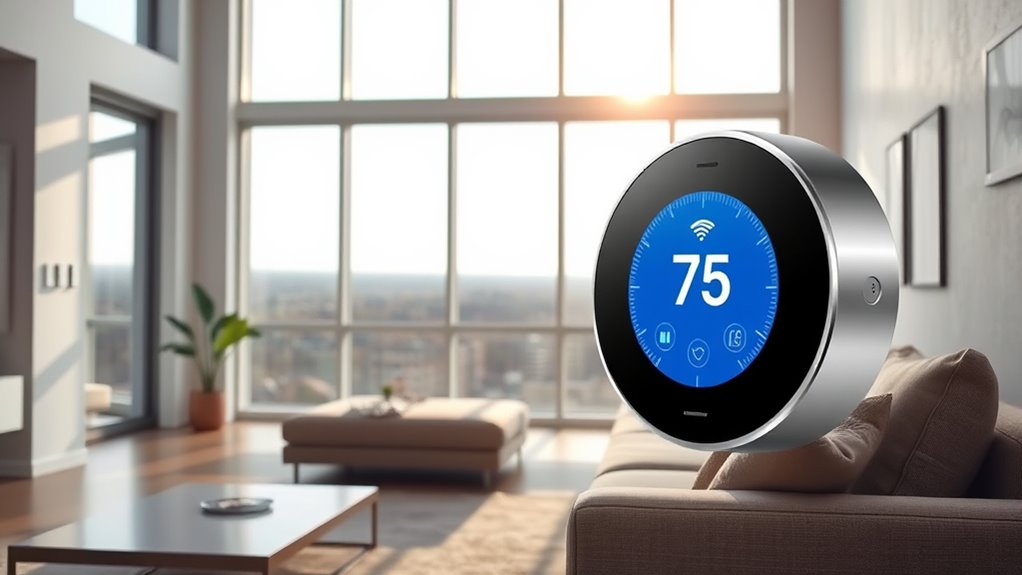
Choosing the right smart thermostat depends on several key factors. I look at compatibility with my HVAC system, installation needs, and how it connects to other devices. Understanding these points helps me pick a model that’s easy to install, energy-efficient, and seamlessly integrates into my smart home.
Compatibility With HVAC Systems
Ensuring your smart thermostat works seamlessly with your HVAC system starts with verifying compatibility. First, check that the thermostat supports your system’s voltage, type (like heat pump, boiler, or furnace), and wiring setup, especially if it requires a C-wire. It’s also important to confirm the thermostat can handle your system’s features, such as multi-stage heating or cooling, dual fuel setups, or zone control. Use manufacturer compatibility charts or online tools to guarantee your specific model and age are supported. Additionally, verify whether your system is battery-powered, hardwired, or needs a power extender kit (PEK). Keep in mind that some systems, like electric baseboard heaters or proprietary controls, may be incompatible and require specialized solutions.
Installation Requirements
When selecting a smart thermostat, paying close attention to installation requirements is essential for a smooth setup and reliable performance. Most models need a C-wire for consistent power, though some offer Power Extender Kits for systems lacking one. Proper wiring, including correct terminal connections, ensures compatibility with your HVAC system and ideal operation. DIY installation typically involves mounting the device, connecting wires to specified terminals, and configuring settings via a mobile app or touchscreen. Before buying, verify compatibility with your existing wiring and HVAC system using online checkers or manufacturer guidelines. For older or complex systems, especially those with specialized heating or cooling setups, professional installation might be necessary to ensure safety and proper functioning. Proper preparation saves time and prevents issues down the road.
Connectivity Options
Connectivity options play a key role in how well your smart thermostat integrates with your home automation system. Most models support Wi-Fi, Bluetooth, and protocols like Zigbee or Z-Wave, guaranteeing flexible connectivity. Wi-Fi is essential for remote access, allowing me to control my thermostat from anywhere through a smartphone app. Voice control is also common, compatible with virtual assistants such as Alexa, Google Assistant, and Siri—perfect for hands-free adjustments. Some thermostats now support Matter, which helps guarantee they work seamlessly across various smart home platforms and future updates. However, reliable connectivity depends on a strong Wi-Fi signal and proper network setup. If your Wi-Fi is spotty, it can impact responsiveness and the stability of remote controls, so network quality is a critical factor to think about.
Energy Saving Features
Energy-saving features are among the most important factors to contemplate when choosing a smart thermostat, as they directly impact your home’s efficiency and your utility bills. Many models can cut HVAC energy use by 23% to 26% through flexible scheduling, occupancy sensing, and automatic temperature adjustments. Energy-saving modes often include geofencing, which uses your phone’s location to prevent unnecessary heating or cooling when you’re away. Usage reports and real-time monitoring help you track energy consumption and find ways to optimize your system. Some thermostats pre-cool or pre-heat your home before scheduled arrivals, ensuring comfort without wasting energy during idle periods. Additionally, participating in utility rebate programs and demand response initiatives can reward you for allowing slight temperature adjustments during peak times.
Smart Home Integration
Ensuring your smart thermostat works seamlessly with your existing smart home setup is essential for a smooth and efficient experience. Compatibility with popular ecosystems like Amazon Alexa, Google Assistant, Apple HomeKit, or Samsung SmartThings allows effortless voice control and automation. Supporting protocols such as Wi-Fi, Zigbee, Z-Wave, or Matter guarantees the thermostat can connect with various devices and hubs. The ability to create routines—like adjusting temperature based on occupancy or time—further enhances your home’s intelligence. Integration with smart sensors and remote control apps makes managing your thermostat simple from your smartphone or via voice commands. Additionally, firmware and software updates that expand compatibility keep your thermostat aligned with evolving smart home standards, ensuring long-term functionality and flexibility.
User Interface Design
Choosing a smart thermostat with an intuitive user interface makes a significant difference in how easily you can operate and enjoy its features. A user-friendly interface with clear, simple controls helps prevent setup errors and makes daily adjustments straightforward. Touchscreens with customizable layouts and backlit screens improve visibility in various lighting conditions, ensuring you can easily read and interact with your thermostat at any time. Logical menu structures and simple navigation allow you to access and modify settings quickly, without confusion. Visual indicators like icons, color codes, and status lights provide immediate understanding of system modes and alerts. Overall, a well-designed interface reduces the learning curve, encourages regular use, and helps you maximize the smart features that make your home more comfortable and energy-efficient.
Privacy and Data Security
When selecting a smart thermostat, it’s vital to prioritize privacy and data security to protect your personal information. I recommend checking that the manufacturer explicitly states they don’t sell or share data with third parties. Look for devices that use strong encryption protocols for data transmission and storage, ensuring your information stays secure. Carefully review the privacy policy to understand what data is collected, how it’s used, and if your activity is monitored or shared. Opt for thermostats with local control options that don’t require cloud connectivity, reducing the risk of data breaches. Additionally, choose models that offer adjustable privacy settings, so you can limit data collection or disable features you don’t want to share, giving you greater control over your privacy.
Frequently Asked Questions
How Do Smart Thermostats Improve Energy Efficiency and Reduce Costs?
Smart thermostats improve energy efficiency and cut costs by learning my schedule and adjusting the temperature automatically, so I don’t waste energy when I’m away or asleep. They allow me to control my home’s temperature remotely through an app, preventing unnecessary heating or cooling. With real-time energy usage data, I can fine-tune settings, save money, and reduce my environmental impact effortlessly.
Can Smart Thermostats Be Integrated With Existing Home Automation Systems?
Yes, smart thermostats can be integrated with existing home automation systems. I’ve done this myself, and it’s pretty seamless. Most models support popular platforms like Alexa, Google Home, or Apple HomeKit, allowing me to control my thermostat with voice commands or automations. Just guarantee your system is compatible, and you might need a hub or app for smooth integration. It’s a great way to make your home smarter and more efficient.
What Security Features Protect Smart Thermostat Data From Cyber Threats?
Smart thermostats protect your data with robust security features like encryption, secure Wi-Fi protocols, and regular firmware updates. I always guarantee my device uses WPA3 encryption and enable two-factor authentication when available. It’s essential to change default passwords and keep the device’s software up to date. These steps help prevent cyber threats and keep my home automation system safe from hackers.
Are There Any Limitations to Using Voice Assistants With These Thermostats?
Yes, there are limitations to using voice assistants with smart thermostats. Sometimes, voice commands can be misinterpreted, especially in noisy environments or with accents. Privacy concerns also exist if you’re worried about accidental activation or data sharing. Additionally, compatibility issues may arise if your thermostat isn’t fully supported by your chosen voice assistant. Despite these, I find voice control convenient, but it’s good to stay aware of these potential hiccups.
How Easy Is It to Install and Set up a Smart Thermostat for Beginners?
Installing a smart thermostat is surprisingly straightforward, even for beginners. I found that most models come with clear instructions and simple wiring diagrams. I just turned off the power, removed my old thermostat, and followed the step-by-step setup via a smartphone app. Connecting to Wi-Fi took a few minutes, and I was up and running. Overall, it’s user-friendly and doesn’t require any special technical skills—definitely doable on your own.
Conclusion
Choosing the right smart thermostat is like finding the perfect key to unfasten your home’s comfort and savings. I once installed a thermostat that learned my routines, and suddenly, my energy bills dropped by 20%. It’s more than just tech—it’s about creating a smarter, more efficient space. So, take your time, consider your needs, and let the right thermostat turn your house into a cozy, cost-saving haven.
